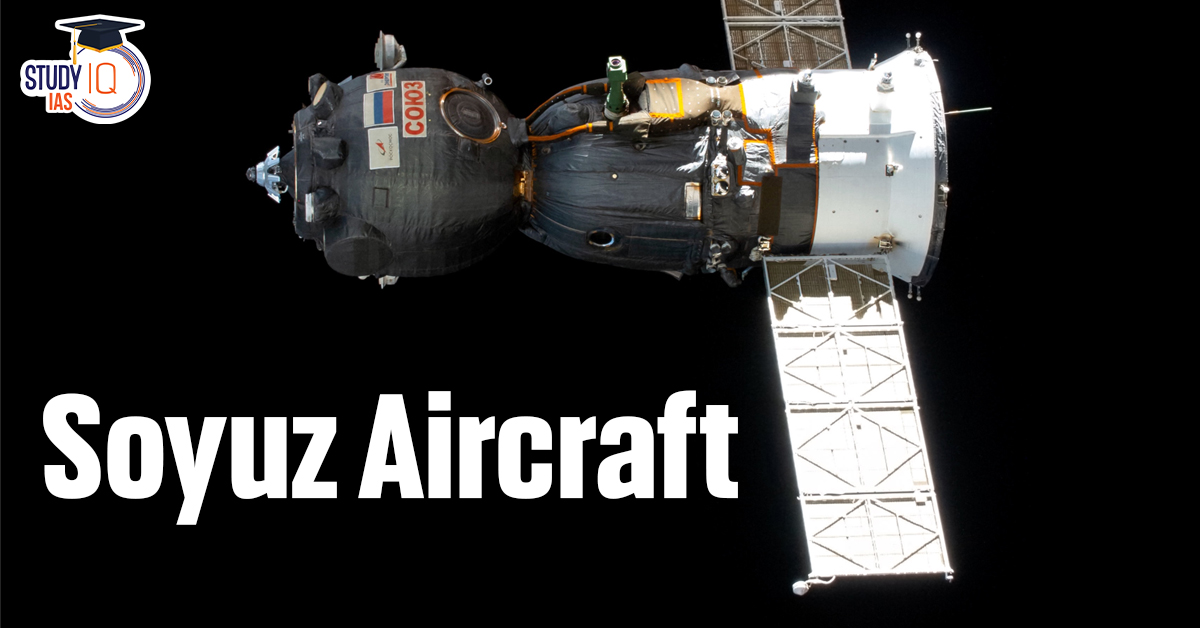Table of Contents
Recently, the Soyuz Aircraft made headlines again after successfully transporting an American astronaut along with two Russian cosmonauts to the International Space Station (ISS). This milestone highlights the enduring reliability and significance of Soyuz in the world of human spaceflight. As one of the longest-running spacecraft programs in history, the Soyuz programme has been pivotal in shaping international cooperation and scientific exploration in space.

About Soyuz Aircraft
- It is a Russian spacecraft that has been used since the 1960s to transport astronauts and cosmonauts to and from space.
- The Soyuz programme is the longest operational human spacecraft programme in the history of space exploration.
- Its first crewed flight into space was on 23 April 1967.
- It can carry up to three
- It is made up of 3 modules: Orbital Module, Service Module & Descent Module.
| Feature | Description |
|---|---|
| Capacity | Up to 3 crew members |
| Launch Vehicle | Soyuz Rocket |
| Docking Capability | Autonomous docking with ISS |
| Re-entry | Only the Descent Module returns to Earth |
| Safety | Proven record with extensive testing and upgrades |
Historical Background of the Soyuz Programme
-
Initiated: Early 1960s by the Soviet Union.
-
First Crewed Flight: 23 April 1967 (Soyuz 1, with cosmonaut Vladimir Komarov).
-
Longest Operational Human Spacecraft: Over 50 years of continuous service.
-
Key Role: Soyuz served as the primary crew transport to the ISS between 2011 and 2020 when the U.S. space shuttle program ended and before the Crew Dragon became operational.
Recent Mission: A Symbol of Continued International Cooperation
Despite ongoing geopolitical tensions, the latest mission involving an American astronaut and two Russian cosmonauts aboard a Soyuz spacecraft reaffirms the continued collaboration in space. The successful docking of the spacecraft with the ISS is a testament to the trust and reliability the international space community places in Soyuz.
Structure of the Soyuz Aircraft
The Soyuz spacecraft consists of three distinct modules, each with a specific function:
1. Orbital Module (Habitation Section)
-
Location: Front section.
-
Purpose: Houses scientific equipment, cargo, and provides living space during orbit.
-
Contains docking systems and sensors for orbital operations.
2. Descent Module (Re-entry Capsule)
-
Location: Central module.
-
Purpose: The only part that returns to Earth.
-
Equipped with seats for up to three crew members.
-
Built to withstand extreme heat and pressure during re-entry.
3. Service Module
-
Location: Rear section.
-
Contains life support systems, solar panels, fuel tanks, and engines for propulsion and attitude control.
Why Soyuz Still Matters in 2025
-
Reliability: With decades of improvements and successful missions, Soyuz has become a benchmark of safety in crewed spaceflight.
-
Backup Transport: Even with the rise of commercial spacecraft like SpaceX Crew Dragon and Boeing Starliner, Soyuz continues to serve as a reliable alternative and backup transport system to the ISS.
-
Symbol of Cooperation: The spacecraft continues to symbolize global partnerships in space, often bridging countries even amidst terrestrial disagreements.
Interesting Facts About Soyuz
-
The spacecraft is launched from Baikonur Cosmodrome in Kazakhstan.
-
Every launch is preceded by a long-standing tradition where crew members plant trees, a tradition started by Yuri Gagarin.
-
Soyuz has undergone several modern upgrades, the most recent being the Soyuz MS series, featuring advanced navigation and communication systems.
Conclusion
The Soyuz spacecraft remains a cornerstone in the global space exploration endeavor. Its historic legacy, proven design, and unmatched operational longevity make it one of the most trusted spacecraft in human history. As we move toward deeper space missions and Mars ambitions, Soyuz will continue to play a key role in Earth’s orbital operations and beyond.


 Places in News for UPSC 2025 for Prelims...
Places in News for UPSC 2025 for Prelims...
 New Phase of Operation Chakra to Combat ...
New Phase of Operation Chakra to Combat ...
 Topological Materials: The Future of Qua...
Topological Materials: The Future of Qua...





















